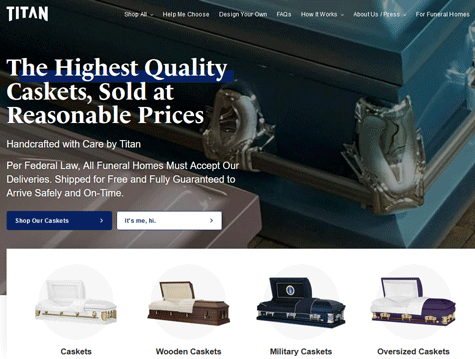Even death gets disrupted
The funeral business can prey on a family’s darkest moments, but the internet has begun to change this. Center Founder Jeffrey Cole explains.
By Jeffrey Cole
Disruption even finds you in death.
Ben Franklin’s quip that “in this world nothing can be said to be certain, except death and taxes” aside, if ever there was an industry that would seem immune to disruptive change, it would be the funeral business.
 Yet, the funeral industry is experiencing a tidal wave of disruption that it does not like one bit. As usual, it is the customer rather than the established business who has the most to gain.
Yet, the funeral industry is experiencing a tidal wave of disruption that it does not like one bit. As usual, it is the customer rather than the established business who has the most to gain.
Many, not all, but many, mortuaries take advantage of grief-stricken families in their time of need.
When a loved one dies—particularly if that death was unexpected—the family is in no frame of mind to make considered financial decisions. This is the moment when the funeral business pounces, framing an expensive series of decisions—how much they spend on the casket, the burial plot, the funeral—as a reflection of how much they loved the family member who just died.
For many families, a funeral is the third most expensive financial transaction they will ever make after buying a house or a car. But we do not approach funeral expenditures the same way. It would seem ghoulish or inappropriate to visit five funeral homes (as we might visit car dealers), get prices, and then negotiate with the first by saying, “another funeral home said they could do it for less.”
At least funeral directors (we hope) do not try to close a deal by asking, “what would it take to get your loved one into a casket today?”
Mortuaries take advantage of us because customers do not know what the law or health codes require. These change by location, and often mortuaries tell grieving families that things are required by law that simply aren’t. The grief stricken have no idea how much the various elements of a funeral and burial should cost.
This is what the internet is best at: shining light into dark places by providing information on what is available, what is required, and how much things should cost.
The information mortuaries don’t want you to find
A quick search will turn up websites where grieving families can learn what questions to ask of funeral directors: what their options and alternatives are, what things should cost, and when a family can save money by buying them from some place other than the mortuary.
Some sites can sort this information by zip code, letting a bereaved family know the laws, practices, and standards in their community.
The most expensive funeral is one that calls for embalming, cosmetic preparation, a public viewing, and a casket. That also means flowers, music (sometimes a live organist), transportation to the cemetery, a burial vault, a graveside service (with somebody to lead that service), and a headstone.
These are the big-ticket funerals that can cost $10,000 or more.
If a family wants to go with a traditional funeral, there are many ways to significantly lower the cost, although mortuaries don’t usually share this information. This information is online. For example, in some places embalming ($500-1,000) is only required if the body will be viewed and if there are more than 4-5 days between the death and the funeral.
A family that has no interest in a viewing does not need to pay for embalming or body preparation (makeup or hair-$500-$700). Open casket funerals are largely an American practice that adds to a funeral’s costs. Most other countries consider viewing of the body unnecessary or even unseemly, as many learned during recent funeral of Queen Elizabeth II.
When a loved one dies—particularly if that death was unexpected—the family is in no frame of mind to make considered financial decisions. This is the moment when the funeral business pounces, framing an expensive series of decisions—how much they spend on the casket, the burial plot, the funeral—as a reflection of how much they loved the family member who just died.
The most significant potential savings at a big ticket funeral is the casket. This is the item with the biggest mark-up for the funeral home. Costs can run from $1,500 to well over $30,000. Many critics claim that funeral homes deliberately stock simple pine caskets that look shoddy to make a grieving family worry about feeling cheap. This is a classic upsell.
What the internet will tell you, but no funeral director will, is that caskets can be bought for significant savings at Amazon, Costco, Wal-Mart, and other places. When these options first became available, some funeral directors—many of whom have been in their communities for generations with deep political ties—lobbied local governments to make it illegal for anyone other than a mortuary to sell a casket. They justified such laws citing sanitation, although it’s clear after a moment’s thought that this makes no sense.
No one wants to buy a casket from Costco and have it delivered to their home in seven days. But that is not how it works.
After the initial efforts of the funeral homes to block outside sales, laws now mandate a funeral home must accept a casket that is delivered to them from an outside source with no additional fees. These caskets are delivered overnight. Checking the website of sellers such as Titan Casket shows all the new laws. Their prices can be 85% less than traditional methods. There is no sanitation issue: these caskets arrive on the same trucks from Titan or Costco as the ones the mortuary orders.
Cremation is even less expensive, and this also eliminates the cemetery in many cases. Historically, funeral homes steered clients away from the low-cost alternative of cremation citing the disturbing image (for some) of fire and the lack of a place to visit the family member.
Cremation has grown in popularity because of cost and environmental concerns, but funeral homes learned how to increase the costs. Now they sell caskets, urns and other procedures bringing up the cost of cremation. Only a few years ago, cremation costs were around $250, but they now range from $1,500 to $2,000 or more. The internet is full of cheaper ways to cremate a dead family member’s body.
This is what the internet is best at: shining light into dark places by providing information on what is available, what is required, and how much things should cost.
And now we have new alternatives
Respect for the environment (tradition funerals put chemicals and other toxins into the ground) and the wish to avoid the thought of a body being burned have led to resomation and composting.
Resomation, often called flameless cremation or water cremation, uses heat and lye to break down a body similarly to cremation, but without fire. It is currently legal in nineteen states. UCLA uses it to dispose of its cadavers. Resomation is a little more expensive than a tradition cremation.
Body composting is now legal in five states including California. The body is placed in a steel box with biodegradable materials that allow it to decompose into soil. The process can take a few months. Families often visit the box during the body’s transition. Composting is new and expensive ($4,000), although the costs will come down if it becomes mainstream. For those concerned about the environment, this new alternative is appealing: a “natural funeral.”
When we think of disruption, we’re usually thinking about computers, smartphones, or some other form of technology. That is true of in our work here at the Center. But the implications of these digital disruptions extend much farther, including into businesses that, at first glance, seem to be as analog as they can get, like the funeral business.
Within a few years, the funeral business will bear little resemblance to what it used to be. As with almost all disruption, the consumer will have more choices, greater control over the process, and far lower costs.
____________

Jeffrey Cole is the founder and director of The Center for the Digital Future at USC Annenberg.
See all columns from the center.
November 2, 2022

